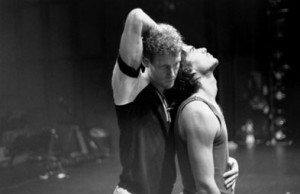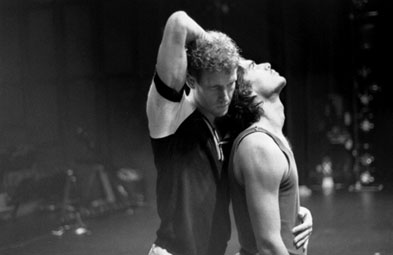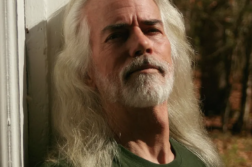A LONGTIME resident of Manhattan with a number of solo exhibitions and group shows from New York City to Provincetown, Gerald Mocarsky is a gay photographer whose work embodies a unique sense of queer urban living. Standing apart from a gay photographic world dominated by nude male Adonises, Mocarsky’s work urges the viewer not to salivate but to observe and think about what it means to be gay in the new millennium. Mocarsky works in series, not unlike Cindy Sherman and Jack Pierson: the images are individualistic, but connected by a universal arc of meaning. His two most recent series relate to dance and cosmetics.

“Men Who Dance with Men” is documentary in nature. Ranging from ballet to country line dancing, with men both young and old, these black-and-white images conjure romantic memories of Fred Astaire and Ginger Rogers, but speak to an alternative passion shared between men that can be understood best as harmonized bodies in motion. In 2009 Mocarsky was profiled in an episode of the PBS/Logo show In the Life, in which he photographed black youths dancing to hip-hop music in New York’s Union Square.
His series “War Paint” depicts images of women over forty applying makeup. Following an art historical trajectory of women at their toilette, Mocarsky re-imagines the work of artists like Edgar Degas and Mary Cassatt in the way the viewer observes these women. “War Paint” is personal memory on display, the childhood vision of gay boys everywhere who watched their mothers and grandmothers putting on their makeup.
Roberto C. Ferrari: What first sparked your interest in photography?
Gerald Mocarsky: The very first photograph I remember taking was of a Heinz ketchup bottle with my sister’s Kodak camera. I remember getting a rush with the feeling that I had given this common item importance and that my sister would wonder why. I always wanted to be an artist but wasn’t sure if I had any talent. I studied all the traditional disciplines—painting, sculpture, and film—but I have to say my decision to be a professional photographer was almost spiritual. My Dad bought me my first real camera for a class trip to the Metropolitan Museum of Art. When I was walking through the museum there were two nuns painting a reproduction of a Bouguereau painting. I quietly asked if I could take their picture, and they nodded yes. I looked through the lens, snapped only one image, and I knew I had captured something special. It was like a voice telling me, “This is what you are meant to do.”
RCF: What photographers have inspired you in your work?
GM: Bruce Cratsley and Helen Levitt have both been huge inspirations to me both professionally and personally. I had the privilege of working and becoming friends with both. I assisted Bruce the last five years of his life. Although he was extremely sick with complications from aids, he showed me a level of dedication to life and photography that I will never forget. I learned from him that a very important part of any good photograph lies in the lighting. Helen was one of the all-time great street photographers. I never tire of rediscovering her work. When she passed away in 2009, it felt as though another beloved part of New York City had been lost. Helen was a woman of few words, but I always remember her saying to me, “A good photograph takes a lot of time. You have to wait for it. You can’t be in a rush.”
RCF: Tell me about the “War Paint” series. Why that title? What do the images signify for you as an artist and a gay man?
GM: The title comes from a conversation I overheard as a teenager between my aunt and mother. When they were young they used to call makeup “war paint.” That reference was so visually rich and symbolic it always stuck with me. On an artistic, visual level, the images signify many different things for me, so it’s best to reduce it to a feeling. It is the sensation you get when things are about to change, the moment before you realize change has happened. Makeup tends to make women look younger, but almost unreal. So when I see a woman transform before my eyes, the tension of change is visual. It is the push from maturity to youth and back to maturity that I’m trying to capture. I want these images to be a bit of a Pandora’s box into how we as a culture feel about women as they age. As a gay man, I feel a strong understanding and connection to that process. Many of the same societal pressures that are placed on women are also placed on gay men. I don’t think it’s a coincidence that I chose to do this project at age 43.
RCF: I imagine a lot of women might feel uncomfortable about participating in this project. How did some of them react to the idea of revealing themselves this way?
GM: Many women who I thought would be great for this project have told me in a very nice way that they were not interested. In the beginning I found much older women were more willing to participate. I think it might be that they’ve had more time to deal with the aging process. Asking a woman to show herself in a vulnerable situation like that is understandably difficult. This hesitation is exactly what I want to explore. I feel their mental image of themselves is far more grim than the reality.
RCF: I’m fascinated by your use of mirrors in many of these works, because it fractures the presentation of the subject. In some of the images, you see the mirror reflection of the person, or a part of her, while in others the mirror cuts into the representation of the face. Mirrors symbolize vanity, but they also suggest funhouse-like realities. What did you have in mind?
GM: I love the idea of seeing one’s reflection in the mirror. The image is not of our mind’s eye; it’s far more accurate than that. I think when people have a healthy perception of themselves, they can feel a love for the reflection without judgment, but for many women there is self-hatred toward that reflection. I also wanted to recreate the dynamic of watching my mother do her makeup on Saturday mornings while I lay on her bed talking to her.
RCF: “Men Who Dance with Men” is another of your photographic series. What meaning does the imagery in these works have for you?
GM: This series is a documentary on male dance partners. Most of the shoots were done during actual dance situations, rehearsals, performances, etc., using a sensitive black-and-white film so I could work with existing lighting. Today when I see men dancing together it signifies acceptance, but as a young gay person it was very difficult to see this. Men being affectionate with each other was very odd and shameful. My hope in showing this work is to give the average person the opportunity to see what male-male affection looks like. It’s my hope that with continued exposure these concepts will become less disturbing to the general culture.
RCF: Would you consider the series politically motivated in any way?
GM: If I were to think of the project as being politically motivated, it would have to be on a grassroots level. At this point in my life I see my role in political change as a split-forked approach. When it comes to issues like funding for aids research and anti-violence legislation, I’m very direct, this must happen. When it comes to changing the hearts and minds of how people feel toward same-sex relations, then I’m more of the school of leading by example. I feel that this is why it was so important for me to have the images be beautiful outside the content. My approach is this: I have something I want to show you; no matter how you feel about the content, it’s beautifully done. I view my art as one of the many, many steps some people will have to take toward accepting and appreciating same-sex relationships.
RCF: You use film for your work rather than a digital camera, correct?
GM: I use a traditional Nikon 35mm camera. I tend to like film that kicks up the drama, usually very fast-speed black-and-white film, so I can use available lighting. I feel this gives more of a theatrical effect. For color, I tend to use Fuji film because of the rich saturation of greens and blues. I will use a very slow shutter speed to get some blurring and camera shake. I love the painterly quality it creates. I have nothing against digital photography, but for my temperament it doesn’t work well. Having to wait to see my images allows me to stay focused on the shoot at hand. I still remember when I couldn’t afford much film and it taught me to be very critical of the image I was about to take. I think people shoot far too many images with digital. You really have an almost unlimited capacity to hold images and I don’t think this allows photographers the same level of focus.
RCF: What other projects are you working on?
GM: Recently I have been teaching a photography workshop for homeless glbt youth at Sylvia’s Place, and photographing some of the residents. I’m hoping to turn this into a series. I also just started a large-format color portrait series on mixed-race people entitled “Other Beautiful Things.” My “Men Who Dance with Men” series is technically finished, but I’m still angling for a way to get to Argentina to photograph inside their gay tango halls.
Roberto C. Ferrari is a doctoral student in art history at the CUNY Graduate Center and a librarian at the Metropolitan Museum of Art.






